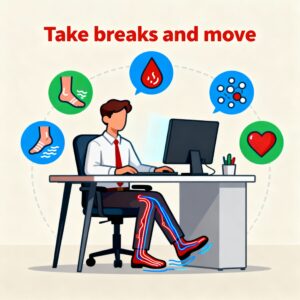In today’s digital age, spending long hours seated at desks, in front of screens, or during commutes has become the norm. But this sedentary lifestyle is silently wreaking havoc on your health, especially your blood circulation. If you’re unaware of the subtle dangers of sitting for extended periods, it’s time to learn how this common habit can seriously harm your vascular health and what you can do about it.
The Hidden Dangers of Prolonged Sitting
When you remain seated for hours on end, your muscles – particularly those in your legs – stop actively pumping blood back to your heart. This lack of movement impairs blood flow, causing blood to stagnate in the lower limbs. Over time, this reduced circulation leads to swelling, discomfort, and even increased risk of blood clots like deep vein thrombosis (DVT), which can be life-threatening if a clot travels to your lungs.
Research shows that blood flow velocity in arteries can drop by nearly 50% during prolonged sitting. The endothelial lining of blood vessels becomes less responsive, impairing their ability to dilate and constrict properly – an early sign of vascular aging. These changes contribute to cardiovascular risk factors such as hypertension and atherosclerosis.
How Sitting Affects Your Blood Flow
Your muscles act as natural pumps that propel blood through the body. When you sit inactive for hours, these pumps cease to function efficiently. As a result:
- Blood pools in the lower limbs, causing swelling and heaviness.
- Oxygen delivery to muscles diminishes, leading to fatigue.
- The risk of clot formation increases, especially in people with existing risk factors.
Sitting also affects upper limb circulation, although to a lesser extent, particularly if you are engaged in repetitive tasks like typing or using a mouse. The constant immobility constricts blood vessels, reducing overall vascular health.
Long-Term Health Risks
The consequences of poor circulation aren’t just temporary discomforts. They can lead to serious health conditions, including:
- Varicose veins: Enlarged, twisted veins caused by weakened valves.
- Venous insufficiency: Chronic impairment of blood flow leading to skin changes and ulcers.
- Increased cardiovascular disease risk: Elevated blood pressure, arterial stiffness, and inflammation.
- Blood clots (DVT): Clots that can detach and travel, causing pulmonary embolism.
The World Health Organization and numerous health experts emphasize that sitting too much is an independent risk factor for cardiovascular disease, comparable to smoking and obesity.
Practical Strategies to Boost Circulation
Fortunately, there are simple, actionable steps you can take to combat sitting’s detrimental effects:
1. Break Up Your Sitting Time
Aim to stand or walk briefly every 30 to 60 minutes. Set timers or use apps to remind yourself. Even a few minutes of walking or stretching can reactivate your blood flow.
2. Incorporate Movement Throughout Your Day
Use stairs instead of elevators, take short walking breaks, or do light stretches at your desk. These small habits accumulate to significantly improve circulation.
3. Use Supportive Wear
Wearing compression stockings during long sitting periods helps reduce swelling and encourages blood flow, especially for individuals with venous issues or those traveling frequently.
4. Exercise Regularly
Engage in aerobic activities such as walking, jogging, swimming, or cycling, which strengthen your cardiovascular system and enhance circulation.
5. Maintain Proper Posture
Sit with feet flat on the ground and avoid crossing your legs for extended periods. This posture reduces pressure on blood vessels and promotes healthy blood flow.
Protect Your Circulation—Start Moving Today!
Prolonged sitting is quietly damaging your circulation and putting your health at serious risk. But the power to protect yourself is in your hands. By consciously breaking up your sitting time with movement, embracing simple daily habits, and prioritizing vascular health, you can prevent swelling, blood clots, and chronic cardiovascular disease.
Don’t wait for symptoms to appear—take control now. Set reminders to stand, stretch frequently, use compression support if needed, and incorporate regular exercise into your lifestyle. Your circulation—and your heart—will thank you for years to come.
*Start your journey to better circulation today! Share this article, adopt these simple tips, and check out the related guides below to boost your health even further.
Final Words
Your body was designed for movement, and prolonged sitting is a silent threat to your vascular health. By incorporating regular breaks and activity into your daily routine, you can significantly improve your blood circulation and lower your risk of serious health issues.
💡 Remember: Every step counts. Make movement a habit, and your circulatory system will thank you for years to come.
